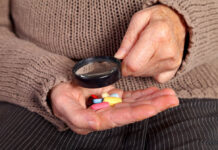Yesterday, the New York Times reported that schizophrenia patients in an experimental treatment program (RAISE) who experienced better outcomes had been on lower doses of antipsychotics than normal. However, the article published in the American Journal of Psychiatry on Tuesday did not divulge any data on the varying antipsychotic drug doses in the different study groups.
The study’s lead author, Dr. John Kane, told the ‘Times, that to minimize the bad effects of the drugs those in the new treatment group received the lowest doses possible- up to 50% less than what is prescribed in standard treatments.
This has led to some confusion—was the quote from the ‘Times article reflective of data that, for some reason, was not reported in the study? Or did the New York Times, in its reporting on the article, make a mistake as to whether those who had the best outcomes received the lowest doses possible?
In a post for the National Institute of Mental Health (NIMH), director Thomas Insel referred to the RAISE program as including “low dose medication management,” but failed to elaborate on the different antipsychotic doses used in the study.
This is an important issue, and hopefully future published articles will detail antipsychotic usage in the study and its relation to varying outcomes.















How stupefied do you want your slave to be?
Too stupid they will pee and defecate anywhere. Too little and they are still “psychotic”.
Report comment
Because they wanted to de-emphasize that aspect of the study, which threatens the psychiatric status quo.
—- Steve
Report comment
Exactly. It is a crime this data is not made public immediately. How can science advance if the data behind studies are hidden?
Report comment
Psychiatry, sadly enough, is more dogma than science.
Report comment
Now, now, let’s be adults here.
The CORRECT , polite term for the drug-racket known as “psychiatry”
is “pseudo-science”. You know, 21st Century phrenology….
My Karma ran over that dogma long ago, too….;)
Report comment
As I was being fed atypical antipsychotics of various brands and dosages over many years I noticed that the pricing for a low dose was the same as for a high dose. So Pharma gets their profit no matter what the dose. The important thing in this study is that medication had to be involved. Whose idea was that?
Report comment
Antipsychotics can be devastating at high doses
Report comment
No doubt, at high doses, or in combination with other drugs, the neuroleptics / antipsychotics actually create “psychosis” and “hallucinations.” The medical proof:
“Agents with anticholinergic properties (e.g., sedating antihistamines; antispasmodics; neuroleptics; phenothiazines; skeletal muscle relaxants; tricyclic antidepressants; disopyramide) … may result in … the anticholinergic intoxication syndrome … Central symptoms may include memory loss, disorientation, incoherence, hallucinations, psychosis, delirium, hyperactivity, twitching or jerking movements, stereotypy, and seizures.”
And the psychiatrists aren’t smart enough to distinguish between the central symptoms of anticholinergic intoxication syndrome and the almost exact same symptoms of “schizophrenia.” One must wonder what percent of so called “schizophrenics” and “bipolar” patients today are actually just dealing with a completely iatrogenic illness, given this reality.
Report comment
….it took me many years to realize, that my so-called “symptoms’ did NOT appear until AFTER I was on psych meds….and since I have gone “shrink-proof”, my
“symptoms” have largely disappeared…..
If I knew *then*, what I know *now*, I would NEVER have gone to those quack shrinks, or taken their poison pills in the first place…..
The LIES of the pseudo-sciemce drug racket known as “psychiatry” have done, and continue to do, far more harm than good….
Report comment
Antipsychotics are devastating at any dose. It’s just the question if you ant to die quickly, slowly or live as a zombie.
Report comment
At least shrinks are getting to the point where they’re (once again) admitting that the antipsychotics have very real, sometimes crippling, effects on people. Personally, I think its because many of the atypicals are now off patent, and they didn’t turn out to be such wonder drugs, anyway.
Antipsychotics aren’t ideal, but I do think low doses can facilitate recovery in some people, if med treatment is mixed with housing, psychosocial programs, vocational help, etc. You know, all the stuff that gets people into society. Without all that, you’re just throwing pills at emotional and social problems and then blaming the “disease” when the person/”patient” fails to become normal and self-supporting.
Report comment
It’s very difficult to come off “antipsychotics” but it’s possible to reduce right down – and eventually get off.
I don’t think I could function normally on anything like a maintenance dose. The dosages that worked were at a 4% to 8% level i.e. suitable for very mild anxiety.
They are tranquillisers after all, but it doesn’t have to be “all or nothing”.
Report comment